Aventon Level.2 Step Thru (ST) Review | Level Up Your Ride
A Popular E-Bike Gets Smarter Tech for a More Natural Ride & Longer Range
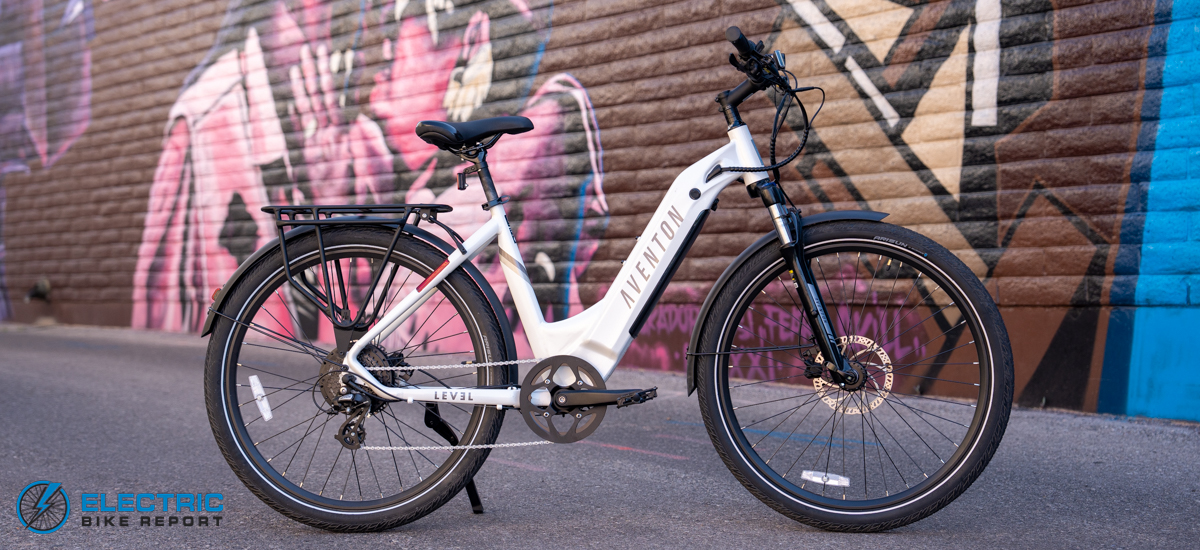
Aventon didn’t overhaul the bike but made a few key changes that have a big impact. Swapping out the cadence sensor for a torque sensor is the most notable upgrade, and it significantly enhances both the bike’s performance and the overall ride quality. Straight out of the box, the difference was clear: the Level 2 ST feels more like a traditional bike, with an added touch of ‘you’re in control.’ The torque sensor encourages a more engaged pedaling experience while still offering the convenience of higher assist levels and throttle when you want to take it easy.
This more natural pedal-assist system also boosts the bike’s efficiency. By augmenting your effort rather than replacing it, the Level 2 ST can cover more ground on a single charge—all without increasing the battery’s size or weight.
Beyond the torque sensor, the Level 2 ST continues to excel at its core mission: being a rock-solid commuter e-bike. It’s fully equipped with everything you need to get to work, run errands, or cruise around town. The new frame colors and integrated taillights not only enhance the bike’s visibility but also add a touch of modern style. As the step-through (ST) version, this model offers the added benefit of easy mounting and dismounting, making it a versatile option for a wide range of riders.
With so many new e-bike options hitting the market every day, you might be wondering: Are the updates to the Aventon Level 2 ST enough to keep it among the best commuter e-bikes out there? Read on to find out what sets this upgraded model apart!
 Pros
Pros- The Level 2 ST is the quintessential commuter. It has all you need out of the box, and feels a lot like a natural bike
- The Step-Through model is generally easier to ride than the high step variant, with two sizes and colors unique to its frame
- New integrated taillight for improved visibility. It’s a small thing, but every day commuters will appreciate the enhanced safety
- The color LCD is easy to see, and not commonly found on commuters at this price
- The 8-speed Shimano Acera drivetrain is responsive. You have plenty of gears for riding up or down hill.
- The Level 2 ST has good Tektro brakes. AA common setup easy to service.
 Cons
Cons- We like the natural feel of the torque sensor, but it trades off faster acceleration some commuters may want
- The throttle get’s you up most hills, but not particularly quickly
- Motor: 500W, 48V rear hub
- Class: Class 2, throttle and pedal assist up to 20 mph (option to set as Class 3 pedal assist up to 28 mph)
- PAS Sensor: Torque sensor
- Controller: 20-amp, 48-volt
- Battery: Removable internal Lithium-ion 48V, 14Ah (672Wh) with LG cells
- Range: Up to 60 Miles (*Using PAS 1 throughout flat terrain with a rider weight of 160 lb.)
- Charger: 48V 3 Amp Fast Charger, 4-5 Hour Charging
- Display: LCD Smart Easy Read Display with Backlight, Colorful screen with app
- Claimed weight capacity: 300 lbs
- Bike weight: 62 lbs
- Brakes: Hydraulic disc brakes, 180mm rotors
- Gearing: Shimano Altus 8-speed, 12-32T cassette, trigger shift
- Crankset: 46T chainring; 170mm crank arm; square taper, sealed bottom bracket
- Fork: Coil spring suspension, Thru-axle, 65mm travel with lockout
- Frame: 6061 aluminum alloy, S/M for 4’11”-5’7″, M/L for 5’7″-6’1″ riders
- Tires: 27.5” x 2.1”
- Rims: 700mm x 54mm, double wall aluminum 36h front & rear
- Handlebar: Aluminum 680mm width, 31.8mm diameter
- Stem: Threadless, 31.8mm, 7 degree rise
- Grips: Rubber ergonomic comfort
- Pedals: 9/16″ alloy platform
- Seat Post: Aluminum alloy, 27.2mm, 2-bolt clamp, 31.8 mm quick release
- Kickstand: Included, rear mount
- Additional: Battery, handlebar mirror, smartphone holder, rack bag, pet basket, Burley trailer, portable air pump
E- Bike Overview: Aventon Level 2 ST Review
Aventon made succinct changes on their original Level that we reviewed a couple years ago. First and foremost was their ditching of the cadence sensor and replacing it with a torque sensor. By far the most significant change, the torque sensor appeals more to commuters because they tend to be much more active with their pedaling. When you’re pushing down harder on the pedals, the torque sensor senses that (cadence sensors do not), and will deliver more motor power to you to help compensate for your efforts.
Switching to a torque sensor was a smart choice on the Level. Not only does the motor engage better with the rider’s pedaling, but this also helps the bike’s battery management system (called the BMS), helping maximize energy efficiency, meaning you can ride farther on this bike than you can on the old version.
Aventon also made a smart choice keeping what worked well with the Level 1. For example, the Level 2 ST still uses the same 500-watt motor. But they did change its calibration, giving you a more consistent engagement and a more balanced speed profile between the five pedal assist levels. Aventon said this is in response to what their customers were asking for, and this is another example of how they really care about what their customers care about.
Aventon now features an app on the Level 2 ST that syncs with your smartphone, enabling you to manage your ride data. The data management feature is great for riders who want to track their fitness activities on a regular basis. It even estimates how many calories you’ve burned in your rides. The app also allows you to change the PAS settings on your bike, without having to tap the settings button on the display. The app also connects you with Aventon’s social media network, enabling you to connect with fellow riders in the community.
Riding on Arisun 27.5” x 2.1” puncture resistant tires, specially designed for electric bikes. The Level 2 ST smoothens its ride with the help of the suspension forks, with 65mm travel, rebound adjustment, and a lockout function to help with uphill pedaling. We found the tires and suspension made our rides smooth and easy to control on whatever terrain we rode it on.
Commuter bikes aren’t normally known for being cargo bikes, but the new Level 2 step-through has a sturdy rear rack that can hold up to 55 lbs of stuff. We like how the weight limit is actually painted on the rack, just in case you need a reminder.
Doing away with the original bike’s more boxy look, Aventon gave the new Level 2 ST’s frame a more shapely look, with a color choice of Arctic White or Himalayan Pink. It also received two integrated tail lights that really light up when the brakes are applied, letting riders in the rear know when you’re stopping, while also keeping you safer on night rides.

Small changes can bring big improvements: introducing a torque sensor means the motor knows how and when to deliver the power you need, when you need it. The increased efficiency also saves battery power, meaning you can ride farther than before on a single charge.

Within reach: thumb switch for accelerating; push button panel for adjusting PAS settings.

Out of sight: frame integrated battery can you take up to 60 miles on a single charge.
There are two frame sizes available for the Level 2, a small/medium size frame suitable for riders who are 4’11” to 5’7”, and a medium/large size frame, for riders with a height of 5’” to 6’1”. That’s a nice option because with other commuter e-bikes you often only have one size available, and need to make do with adjusting the handlebars and seat height. Aventon has their own manufacturing location, which means they have the flexibility to offer more variety to their customers, and we think that really matters when you commit to buying.
That’s a lot of information we just covered, so how does that carry over to the way this bike performs? The answers to these questions are coming up next.
Circuit Speed Test: Aventon Level 2 ST Review
The chart on the screen lists the specifics on the speed changes using each PAS mode with the new torque sensor. The acceleration was pretty balanced. The circuit test is where we really noticed the improvement the torque sensor brought to this bike. As soon as I started pedaling in PAS 1 I could feel the torque sensor respond and offer meaningful pedal assistance.
If you’re new to torque sensors, keep in mind that it responds based on how hard you’re pedaling. If you click to the next higher PAS and it seems like there isn’t much additional power output, it’s likely because you are pedaling too soft for the torque sensor to determine you more assistance. As soon as you start pedaling harder, you’ll notice the torque sensor immediately kick in.
The speed increase leveled off when clicking into PAS 4 and 5. This felt a little anticlimactic compared to the bigger speed gains in PAS 1 – 3, but that did not diminish the overall ride when cruising in PAS 4 and 5. Here at EBR, most of us are active pedalers, so we ride in PAS 3 more often. Using PAS 3 as our main cruising level enhanced our pedaling experience, and it helped us extend our range by not using as much battery power as we would use in the higher levels.
All in all, the torque sensor will give you better motor engagement with your pedaling, in all PAS modes, and it will conserve energy consumption, giving you more riding miles – and more fun!

Along for the ride: better bike features for less money, the Level fits many sized riders, providing comfort, ease, and reliability, enabling you to have more fun and just focus on your ride.
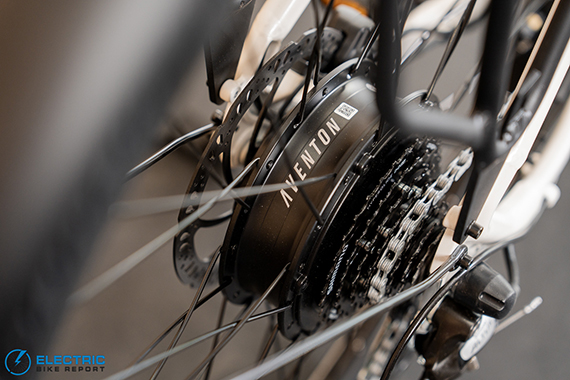
500W motor, 8-speed gearing, and 4-mode PAS give you consistent power at slow & fast speeds.

Take your stuff with you: 55 lb capacity means there’s a lot you can load on your rear rack.
Range Test & Battery Performance: Aventon Level 2 ST Review
“How far will the battery take me?” That’s a common question we get from readers here at EBR. Comparing the Level 1 ST to the Level 2 ST in terms of battery range was our main question when doing the range tests. How much better, if at all, would the Level 2 ST do over the earlier version? The short answer is that the Level 2 ST range increased significantly.
Determining the battery’s range involves two tests. In the first, we ride the bike in the lowest PAS setting for pedaling, and see how many miles the bike will go before the battery runs out of juice. In the second test, we use the highest PAS setting, for maximum power output, and ride the Level until the battery uses up all its power. That gives us a maximum ranger using maximum power, and a minimum range using minimum power.
In the Min PAS test, riding in PAS 1 the whole time, this bike went 51.21miles, in 3:57, and an average speed of 12.96 mph. When we did the same test on the Level 1 bike it only went 42.33 miles, meaning the new Level 2 increased its range by almost 10 miles. Getting an extra 10 miles out of each charge is a free gift we’d all love to have.
On the Max PAS test, riding in PAS 5 the whole time, this battery had enough juice to take me 38.14 miles, time of 2:11, avg speed 17.4 mph. On the old bike we only went 23.31 miles, at the same average speed of 17.4 mph. Here again we see a notable range increase of almost 15 miles with the new Level. Keep in mind that both bikes use the same 14 Ah battery, so this improvement has everything to do with replacing the cadence sensor with a torque sensor and re-calibrating the pedal assist system. These differences are pretty significant and highlight how the torque sensor really improves this bike’s ride.
Hill Test: Aventon Level 2 ST Review
Our hillclimb test is rigorous and is meant to help us identify the e-bike motor’s raw power and how it distributes that to the rear wheel. This is not a pass/fail test. Some great e-bikes have struggled on this test. For the hill test, we use one of the steepest hills around: Southwest Utah’s Hell Hole Trail.
In the first part of the test, using the throttle only without pedaling, you can evaluate the raw power of the e-bike. The Level 2 ST did not make it all the way to the top on the throttle-only test. We weren’t surprised by this. Seeing as how the Level 2 high step we tested a few months back just made it up the hill this wasn’t a total shock with me riding it this time and the few extra pounds I have on our main hill tester, Justin likely making the difference.
The second part of the test involves basic pedaling while utilizing the highest Pedal Assist System (PAS) level, specifically PAS 5. This test examines how effectively the e-bike’s motor assists the rider during pedaling. It demonstrates the bike’s climbing ability when the rider combines their own pedaling power with the motor’s assistance. PAS 5 is the highest level, suggesting it provides maximum motor support, which is particularly important for conquering steep inclines.
When we did the 2nd hill climb test, using PAS 5 and doing basic pedaling, the Level 2 reached the top of the hill with a time of 1:24, at an average speed of 12.9 mph. So, you see, this bike can climb monster hills, like Hell Hole, as long as you’re contributing pedal power. After all, this is still a bicycle, not a motorcycle.

Free to roam: The Level.2 ST battery uses energy more efficiently so you have more power to ride longer, giving you more reasons to hit the road on two wheels, instead of four.
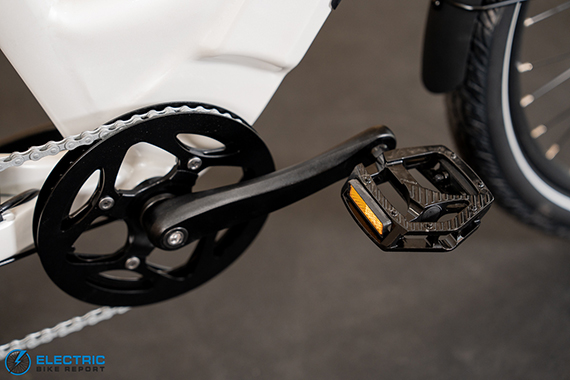
No boundaries: The 46-tooth chainring gives the right balance of easier pedaling up hills

Popular choice: the Tektro hydraulic disc brakes provide ample stopping power.
Safety and Brake Test: Aventon Level 2 ST Review
I found this bike braked well when I did an assortment of test rides, including stopping at the bottom of some steep downhill trails, where my speed was 25 mph or more. Rather than having to feather the brakes to help me slow the bike while riding downhill, I was able to coast at top speed on the Level, and use the brakes at the bottom of the hill to safely stop. I was happy to see these brakes handle my somewhat aggressive riding style.
Overall, theTektro HD-E350 hydraulic disc brakes on this bike stopped well for me consistently. Using 180mm rotors, and dual piston calipers, these brakes performed well repeatedly. And speaking of reliability, Tektro is known as a reliable bike brake brand and you can find Tektro brake parts almost anywhere, making it easier for you (or your bike mechanic) to find parts, come service time.
Ride Comfort & Handling, Cockpit, and More: Aventon Level 2 ST Review
Commuter e-bikes handle and ride better when they have decent suspension, lighter weight and a frame size that pairs well with the rider’s height and weight.
The handlebar, grips, levers and display controls are pretty important to consider when looking to buy an e-bike. Being in control doesn’t always mean feeling in control on an e-bike. Certain nuances like slippery grips or difficult to operate display units can make riders feel like they’re not in control, diminishing their confidence and spoiling their ride.
Fortunately, Aventon did their homework when designing the Level 2 ST. The 680mm aluminum handlebar fits that happy medium of being narrow enough to twist and turn the bike around pedestrians, bikes and other obstacles on the path or road, while also being wide enough to help the rider control the bike better. The ergonomic rubber grips enhance that experience because it’s easier to keep a hold on rubber grips than on faux leather grips – especially when wet. And the simple 4-button PAS panel means you won’t have to deal with too many intricacies changing settings in the middle of your ride.
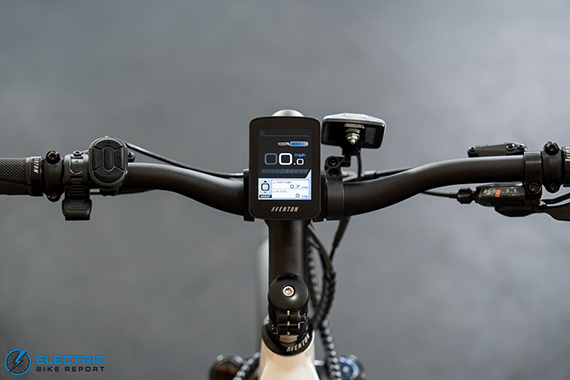
Cognitive cockpit: everything you need to control your ride, right at your fingertips.

Shopping time: with a 55 lb cargo capacity, you can get creative in what you’re going to carry.
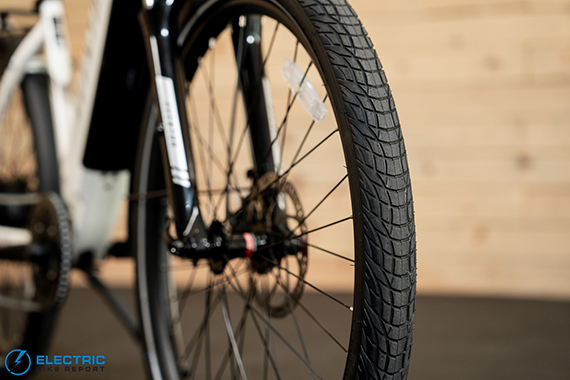
Ride on: puncture resistant tires with serious road tread , the Level 2 ST is ready to go.

Rough road ahead: coil spring suspension, with 65mm of travel to soften your ride
Being able to see the information on the LED color display is also very important. I had to remove my sunglasses under the midday sun in order to read the info on the Level 2’s display. I had the dimmer switch turned all the way up and it still wasn’t bright enough for my shades. The PAS reads well the rest of the time and provides important data, like speed, PAS level, trip time and trip miles, total miles, and battery life.
Also easy to reach and control were the left thumb throttle, and front and rear brake levers. All-in-all, this bike was easy to operate because I was comfortable with the cockpit controls mentioned above.
Summary / Where to Buy: Aventon Level 2 ST Review
Having so much to like, such as a motor with quick engagement, a range beyond 50 miles, a smooth ride, and a sturdy rack to carry up to 55 lbs of cargo, then it’s easy to see why the Level 2 ST has been the bike of choice for many commuters, and will continue to be.
DIY mechanics should appreciate the phone and online support Aventon offers. I used them to help me take care of a software update on my Aventon e-bike (not revealing who I was), and they were wonderful to work with.
Adding icing to that cake is the fact that Aventon offers a limited 2-year warranty. Shipping is free to all 48 contiguous US states, and there’s a conditional 14-day return policy in case you decide not to keep the bike.
Happy Riding! Make sure to let us know if you have any questions down in our comments section or if you think we left anything out in this review of the Aventon Level 2 ST.





There’s a good reason no other manufacturer has copied the seat-stay integrated taillight; they’re invisible to following traffic when you mount pannier bags. A senseless choice for a commuter, and an unfortunate deal-breaker for this otherwise nicely equipped bike.
You can see that – why didn’t the designer?!* We have people here in the UK who fit a rear light on the seatpost, because it’s easy, then ride off wearing a coat that covers it completely. The Van Moof bike seems to have the same problem. I made two small posts and bolted them right at the rear of the rack, which makes them clearly visible and I can fit and remove the lights easily.
It is not true that following traffic cannot see the taillights with panniers mounted. Panniers block the lights for side traffic, though. Can’t have everything. I have a very bright taillight mounted on the back of my helmet. And, by the way, only another cyclist would care about your brake lights. A bicycle is basically stopped as far as a following motorist is concerned.